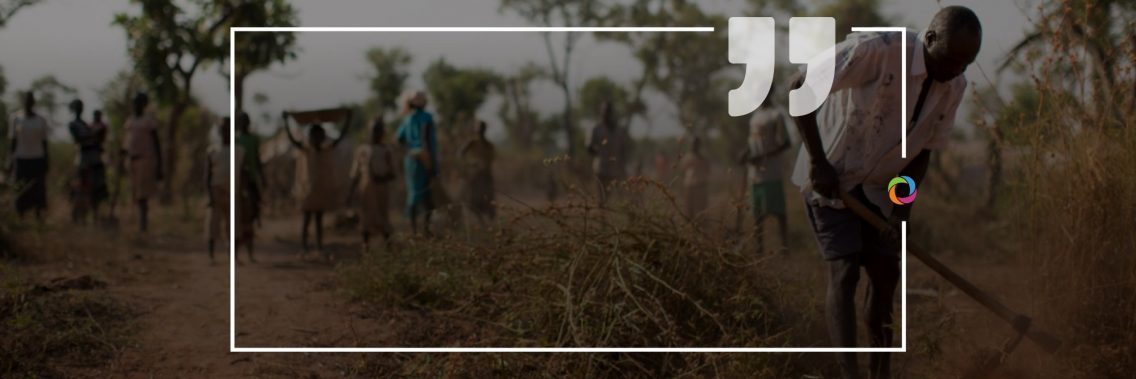In recent years, the concept of ‘localization’ has become used more and more in debates about international aid. This term broadly refers to providing emergency and development aid through ‘grassroots’ organizations avoiding intermediaries. We discussed the advantages and disadvantages of localization in the humanitarian sector with several aid experts. Check out their opinions below.
What are the advantages and disadvantages of localization in the humanitarian sector?

“The last five years have seen a growing call for the localization of humanitarian aid. The essential role that local actors play in effective, efficient, coherent, and sustainable humanitarian aid has been highlighted in the commitments, among others, of the Core Humanitarian Standards (2015), the World Humanitarian Summit (2016), and the Grand Bargain (2016; 2021). COVID-19 added to the complexity of humanitarian crises and has further highlighted the necessity of strengthening local leadership in humanitarian action. From my experience in an aid localization program in the Lake Chad Basin region, it is difficult to use the term “disadvantages” regarding aid localization. I choose to underline the overarching challenges toward this localization. Local actors are often part of a political field that is difficult to reconcile with humanitarian principles. Also, the humanitarian sector remains misunderstood by most local actors. Finally, the issue of resources (financial, technical, human) is by far the most critical. National and local organizations do not possess these resources and very few have succeeded in setting up reliable internal governance systems and transparent, safe, and secure mechanisms to better attract them. Yet, it cannot be said enough: “the present and future of humanitarian action requires more aid localization”. We need an inclusive humanitarian sector for innovation and acute delivery. Increased local leadership is the guarantee of a sustainable, resilient humanitarian aid that places affected populations at the heart of the response while anticipating the future. Local actors are present before, during, and after crises and understand the contextual hidden realities/practices. They facilitate the dynamics that address the root causes of humanitarian crises. Local actors have a solid credit of trust within communities increasing the likelihood of responding to needs and priorities in an efficient and inclusive manner. For the benefit of crisis-affected boys, girls, men, and women, the humanitarian sector has everything to gain by strengthening local ownership and leadership at both strategic and operational levels.”

“This subject has been discussed for a while over the last decade. So far, no much or less has been done to make it widely used in international or development aid delivery. Localization is another way of responding to local constraints (security, sanitation, bans, etc.) to accessibility but should not mean the end for this wonderful human being exchange platform between nations. Who is controlling the donors to not take this opportunity as granted for abuse? Or leave communities with the best excuse to do anything other than begging? Advantages: Gain in assurance for national partners by making them freer to endorse this responsibility; Opportunities to really feel and hold the values of the Global World System. It’s finally a step forward to create more local dynamism that is capable to carry and share the vision of the SDG targets. Disadvantages: Serious threat to maintain aid neutrality especially when a national counterpart does not have the professional approach required to respect the humanitarian aid principles of neutrality -impartially and independence. Taken as a concept to empower national bodies, communities, or any system working in the domain of social protection, this concept is more than useful. It’s a step forward to making the aid received to be more sustainable and would create a frank exchange between national leaders and their communities. Finally, taken as an approach to reduce budget expenditure, it becomes counterproductive. In fact, we could easily send a bank transfer to beneficiaries and wait for them to accomplish the terms of social contracts signed with the donors. Therefore, there is no more space of sharing, the cycle of a project and program might not be implemented to maintain and resolve issues taking a long-term perspective of the needs expressed by beneficiaries. This direction would create a more drastic reduction in the funds just because there is no accountability.”

“The ‘Grand Bargain’ agreement in 2016 between donors and humanitarian organizations at the World Humanitarian Summit marked a formal recognition that local people are often the first responders during emergencies and the best placed to provide support. Since then, much effort has gone into promoting the so-called ‘localization’ of humanitarian aid and empowering local responders, both civil society and public authorities. The idea behind this is that local entities have lower structural and staff costs, with enhanced access to remote and difficult areas. They also have a better knowledge of the socio-cultural context which means that they can understand the needs and challenges faced by local populations. They are broadly recognized as more agile and, through their engagement, the provision of cost-effective humanitarian aid helps to build bridges between humanitarian and development work, creating resilience to future shocks. But the approach does not only entail advantages. Indeed, while local actors are geographically and culturally closer to affected people, they may have strong biases towards certain vulnerable groups, or worse, have a hidden economic or political agenda. The elephant in the room is the enhanced risk of having aid delivery falling short of humanitarian principles such as impartiality (discrimination through aid provision) or neutrality (supporting one party in a conflict). To be true to the ‘do no harm’ principle and be aligned with the protection of human rights, the localization of humanitarian aid must entail careful conflict sensitivity assessment, as needed, and be coupled with creative ways to overcome the risks linked to decentralized models.”

“In the years of building my career in humanitarian aid and development approaches both on the programmatic as well as the academic side, I have encountered cross-cultural and multilateral beneficiaries of humanitarian assistance and development programs who think that humanitarian aid is expensive, lacks transparency, and evades accountability, produces further dependence on aid, does not always lead to long-term development programs, is seen as the political hegemony and a tool of interference for super-rich countries to manipulate poor countries, is less effective in delivery and ensuring equality and inclusion, does not provide for people as beneficiaries to have a say or to be heard, cannot create and ensure local ownership, and is neither durable nor measurable and is not sustainable. These indicators inspired me to dig deeper and initiate a series of independent research and scholarly studies on human behaviour patterns and the challenges of long-term humanitarian assistance and development on grass-root, national, international, and global levels. In light of the fact that humanitarian aid cannot be sustainable or lead to long-term development and that development as a process as well as a product eventually challenges the status quo and ultimately brings about change, it needed no argument that change is not necessarily something that everyone would favour and/or to find change to be in their interest, especially among the ruling political elite and key players and interested owners of the market economy. These studies in a nutshell revealed that in the absence of political commitment, legal provisions, legislative framework and institutional capacity necessary for programmatic flexibility and the lack sustainable financial support and resources, long-term humanitarian aid and the process of development is counterproductive and less effective to provide for and ensure the participation of the very people whom they intend to address. My findings from fieldwork revealed that on practical grounds humanitarian aid and development programs at local and grass-root levels fail to provide for and allow the beneficiaries to have a say in establishing a consensus mechanism on prioritizing their needs and do not consider or mobilize the collective will of the beneficiaries to participate in the programs, thereby remaining more prone to a lack of accountability and producing more aid-dependence, development-resistant tendencies and suspicion rather than actually alleviating suffering or producing sustainable outcomes. After all, humanitarian aid does not necessarily lead to development, and the impoverished and needy communities and countries do not necessarily have the popular and political will to develop or see development as the solution to their problems or the way out of their crisis.”

“The concept is accepted in the humanitarian sector, but some organizations are still hesitant to fully endorse and implement such an approach. There are many reasons behind this, particularly that humanitarian actors are looking at the disadvantages or the risks rather than looking at the outcomes and the advantages. The localization plan has been unsuccessful in the past few years, and this is no secret. Firstly, the critical challenge for successful localization is to know what ‘localization’ means in practice, how we should plan for it, and how we see if it is happening. Both donors and international NGOs have often focused their grant flows on local NGOs which look and sound similar to their own organizations while ignoring other potential frontline responders – including community-based organizations, business leaders, and faith-based groups. Even when ‘local’ groups are used to implement projects, agencies maintain a high degree of control over when and how funds are spent. Donor requirements also present a challenge to shifting power to local actors. International donors are driven to provide large grants to a select number of ‘trusted’ NGOs rather than funding more decentralized models that entail some risk. Furthermore, the whole concept of capacity building within localization is seen as one-sided. Questions regarding capacity usually refer to the local actor, but what about the international funders? Why is their capacity never questioned? NGOs look at localization as a risk, especially in conflict zones, because it includes involving and empowering local authorities. This has caused some controversy as governments have different powers and responsibilities than NGOs and therefore are expected to operate by a different set of standards. I believe that things may now be changing because many NGOs are seeing the advantage of localization which recognizes and supports the local community in being the leaders, decision-makers, and implementers of the solutions impacting their country. The specifics of its implementation may be currently under microscopic review but the greater concept of shifting power to local actors is regarded as a step in the right direction towards lasting positive change. For example, as shown in the Ebola outbreak of 2014, local actors in Liberia, Sierra Leone, and Guinea were paramount in the response as the main UN/NGO implementing agencies were not present on the front lines of the emergency. Local knowledge, relationships, and experience are often devalued. Finding new and creative ways to utilize these attributes is crucial. It is clear the global humanitarian system requires transformation and more decentralization.”

“Efficient delivery of aid packages to the doorsteps of target beneficiaries is a challenge the donor community still grapples with. Of late, the localization of international aid has gained traction among donors. The use of grassroots organizations helps to shorten the time in delivering humanitarian aid packages to the beneficiaries through the elimination of a tier in the process. Other advantages include their better understanding of the local conditions and needs of the target beneficiaries as they comprise mostly local staff. The method also helps to save time and money involving another party in the process entails. The success of using grassroots organizations, however, hinges on the degree of autonomy that the local administrative bodies enjoy at the grassroots level and the strength of the NGO network at this level. The state of infrastructure, especially roads and storage, at the grassroots level is another critical element for the success of this means of aid delivery. The most dreaded disadvantage of using grassroots organizations is that it may throw the aid delivery programs into a total mess unless applied judiciously. Many donors are forced to use intermediaries to deliver their humanitarian aid packages to the grassroots since some regions do not adequately meet the given conditions. These intermediaries in turn mostly use the grassroots NGOs for the distribution of aid among the target beneficiaries. They provide the necessary training and guidance to the local NGOs and oversee the program implementation on the donors’ behalf. Their use helps to avoid the catastrophe that the indiscriminate use of grassroots organizations may cause. There is no one-size-fits-all means of aid delivery which will work well in all situations. Prevailing conditions should be taken into consideration to determine which method of aid delivery is the best fit for a particular region.”

“Going grassroots is a concept agreed by the signatories of the Grand Bargain which has taken its place in many aid organizations’ stances and especially after COVID-19 will resume as an indispensable approach. I am of the idea that the provision of aid without intermediaries could not have any disadvantages. Only if going grassroots occurs immediately without adapting and transferring the necessary expertise, there might be the possibility of it resulting in practical implications. Any other pitfalls and bottlenecks are manageable through cumulative learning. However, the advantages vary more than the disadvantages: Grassroots organizations have the greater advantage of being ‘native’ in any aspect. A bird’s eye view of grassroots organizations provides the live analysis of viability in terms of rapid changes, not only during the kick-off phase but also throughout the implementation process of projects and programs. Going grassroots could also prevent funding imbalances, ensure improvement and capacity building, a better response and advocacy as well as strengthening the coordination between different stakeholders. Equality in decision-making by going grassroots gives them their voice back, makes people the actors of their own lives in that sense, harmonized with the empowerment aim of international aid. I also think that transparency and accountability mechanisms have a better working capacity with grassroots organizations. Finally, in areas of dispute and for emergency response, going grassroots is a must to get the social license to operate for the affected people to own and embrace the aid and prevent the legal obstacles by the recruitment of locals.”

“With the changing humanitarian aid narrative, local civil society and at-risk people can participate, influence, and take decisions on risk-informed development policies and practices. In realizing this, there is a need for structural changes at the local, national and international level, where local actors have the capacities, resources, and power they need to decide how to strengthen their resilience. Local actors bring specific skills, knowledge, access, and the ability to understand and adapt to the local context. The local actors have critical knowledge and experience of the threats they face and their consequences, the actions that help to reduce risk, and the barriers to those actions. In the context of the localization agenda, certain local actors who are not neutral and impartial can be considered as a challenge and this applies to INGOs too.”

“The advantages are threefold: 1) More funding equates to more delivery as more intermediaries are removed, 2) More empowerment of local systems and structures, 3) More opportunities for other players (nontraditional donors) to build relationships with strengthened civil society (Chinese NGOs, philanthropists, foundations, private firms) who don’t want to rely on Western aid. The disadvantages are linked to each of the advantages: 1) More funding equates to more opportunities for distorted economies, power struggles, and corruption, 2) Stronger local systems can distress Western systems of oversight and challenge the imposition of their systems, 3) The unknown of alternative aid (China’s CIDCA, Turkey’s TICA, etc) partners will be a challenge to Western Foreign Policy and soft power.”
Check out more than 460 job opportunities in the migration sector here.

